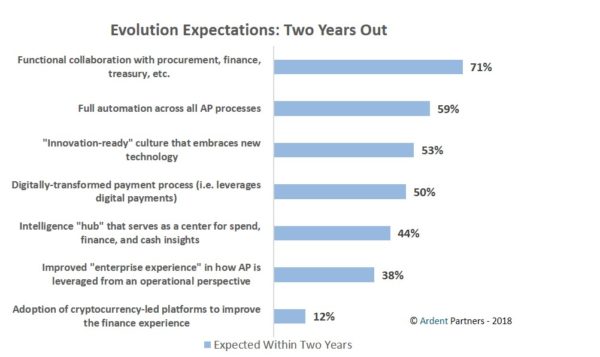[Editor’s Note: Ardent Partners recently published our annual AP-themed report, The State of ePayables 2018: The Future of AP is Now. Today’s article is part of an on-going series focused on the report’s key findings. If you would like to get the full report, it is available for download here (registration required).]
The discussion of where Accounts Payable (“AP”) can go in the months and years ahead is deep and complex. The AP function has many avenues in which to not only enhance its own operations but also become a true partner in the digitized enterprise of the future. Both strategy-led and innovation-heavy approaches pave the way for AP’s future over the near and longer term. But no AP department, or enterprise for that matter, operates in a perfect vacuum. Although market pressures (borne by the weight of needing to “keep up” with digital innovations) may hijack the minds of key executives and force them to condense transformation timelines, the truth is that every organization is different. What works for one enterprise in regards to digital enhancement may not be aligned with another.
That said, it is helpful to understand how AP will look in the next two years as a means of better aligning itself with the greater digital goals of the business at-large. In Ardent’s ‘The State of ePayables 2018: The Future of AP is Now’ research report, we discuss several key aspects that are expected to play critical roles in the ultimate evolution of the AP function over the next two years, as shown in the Figure below.

AP 2020: The Evolution of AP
The ideas listed in the figure above represent the expected trajectory and path forward for the AP industry while also highlighting opportunities and new potential areas of influence held for AP organizations. The main areas expected to impact AP over the next two years include:
Functional Collaboration (71%): It is telling that 71% of businesses expect to experience active collaboration and partnership between AP and functions like procurement and treasury within the next two years. This functional coordination will not only help to push AP’s intelligence into other key units that can benefit from its deep data and information, but will also boost the overall strategic value of the department. The teams that can actually (and actively) institute cross-functional coordination are the ones that will understand how their operations (and respective technologies and systems) can align with other key stakeholders and corporate peers, and generate value for their organizations.
Full automation (59%): While a fully automated AP operation remains an exception rather than a rule, 59% of AP leaders surveyed expect to take that next step within the next two years. Businesses are beginning to realize that automation will become a key part of the AP function. Full AP automation is seen as an ideal “first step” in the long-term digital transformation of the function (and its place alongside other teams in the digitized enterprise of the future). The quest for AP automation is a long-term journey, not a destination along the way.
An Innovation-Ready Work Culture (53%): Within the next two years, more than half of businesses expect to be a part of a workplace culture that embraces new technologies and systems. For many within AP, corporate culture is often a top barrier to adoption new technologies and solutions. Overcoming the archaic perception of automation, AP should be able to effectively join its peers in the digital revolution. The functions that expect to play a critical role in the future of their organization must work to transform its culture to one that embraces what next-generation technology has to offer.
Conclusion
Forward-thinking AP teams are constantly looking toward the “next step” required to push the AP department to a higher level of performance. This is an important attitude to have, especially because the business world is only becoming more competitive. Reaching key goals over the next two years, such as better collaboration, the addition of more technologies to automate key aspects of the P2P process, and building a workplace culture that embraces those technologies, can help AP teams to stay competitive and showcase their true strategic value to the enterprise. That way, everyone wins.
RELATED ARTICLES:
Download the State of ePayables 2018 Report!
The State of ePayables 2018: What Makes the Best AP Departments Better?
The State of ePayables 2018: 3 Things AP Can Do To Be More Strategic







Comments are closed.